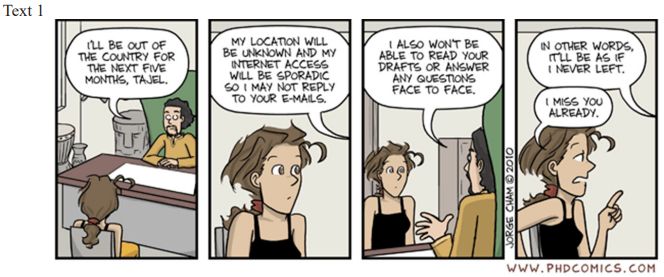Questões de Inglês para Concurso
Foram encontradas 16.706 questões
In Language Testing and Assessment: An advanced resource book, Fulcher and Davidson (2007) state that there are important differences between largescale testing and classroom assessment, although the latter usually benefits from concepts presented in studies related to the former. Based on such divergence, it is correct to say that:
Assertion (A)
When designing an English for Specific Purposes (ESP) course, the first stage is to carry out a rigorous needs analysis of the target situation and only after that the organizational patterns in specific texts should be identified to specify the linguistics means by which they are signaled. After adding such patterns to specific register and lexical components, the course design is ready. Thus, there are just these three stages in ESP for Hutchinson and Waters (1987).
Reason (R)
Using the analogy of a tree, Hutchinson and Waters (1987) defined ESP as a language product whose root is English Language Teaching (ELT) and branches are English for Academic Purposes (EAP) and English for Occupational Purposes (EOP). Thus, the main point of ESP is to teach specialized vocabulary.
Literacy involves having the wherewithal to base one’s interpretive and creative decisions on one’s personal purposes, one’s understanding of the medium one is working with, and the conditions of possibility of reception, acceptance, or rejection by others. The importance of the medium translates into a number of pedagogical goals for language and literacy education:
• To develop learners’ ability to reflect on relationships between language forms and their material contexts.
• To make learners aware of how those relationships change over time and through different mediums and different cultures of reading (i.e., to make learners aware of the historical precedents that have helped shape the communication technologies they use).
• To develop learners’ ability to analyze mediums to identify their ideological (or commercial) underpinnings, and to be aware of how mediums can be used to manipulate consumers and citizens, and to resist such manipulation. To accomplish these goals, teachers should engage learners with questions about how the new media born of the digital age relate to ‘old’ media, and perhaps even ancient media, to allow them to discover what aspects of literacy have remained relatively constant, which have changed, and what the significance of those changes might be.
KERN, Richard. Language, literacy, and technology. Cambridge University Press, 2019.
Based on the text, which of the following best describes the pedagogical goals for language and literacy education in the context of media?
Introductory classroom Young EFL learners in an English language school. Teacher starts the class asking a strong learner, ‘Enzo, how are you?’ The learner responds, ‘Fine, how are you?’. The teacher continues, asking different learners, who respond in turn: Teacher: Sophia, how are you? Student: Fine, how are you? Teacher: Francisco, how are you? Student: Fine, how are you? Teacher: Valentina, how are you? Student: Fine, how are you? If a learner struggles to produce the response, the teacher demonstrates the correct utterance by first mouthing the syllables and then saying them aloud if necessary. The teacher corrects pronunciation, particularly emphasizing the /h/ sound in ‘how’ by breathing on her/his hand as if using a mirror, and drills the prompts with the students. The activity continues until every learner has been asked and has provided the correct response.
In Avaliação da aprendizagem de línguas e os multiletramentos, Duboc (2015) states that the emergence of new literacies in the post-typographical society is closely related to a new understanding of subject, language and meaning making processes. Regarding knowledge construction in both moments discussed by the author, it is correct to say that:

Fonte: Disponível em: https://phdcomics.com/comics.php?f=1374.Acesso em: 30 ago. 2024.

Fonte: Disponível em: https://worldofmirth.com/products/ ugh-as-if-clueless-vinyl-sticker. Acesso em: 30 ago. 2024.
How does the semantic use of ‘as if’ in the final panel of the comic strip in Text 1 contrast with its application in Text 2?

Fonte: Disponível em: https://www.cartoonstock.com/ cartoon?searchID=CS249584. Acesso em: 2 ago. 2024.
The comic cartoons, frequently, highlight an interesting linguistic construction often censured by grammarians: the use of double negatives to articulate a single negation. The critique of double negatives is based on the notion that negation is an absolute concept; something is either present or absent, and adding a second negative into a sentence does not make it more negative than it was before. However, Swan (2005, p. 364) reminds us that “multiple negatives are sometimes used instead of simple positive structures for special stylistic effects. This is rather literary; in spoken English, it can seem unnatural or old-fashioned”. In which of the alternatives bellow there is a purposeful use of a double negative structure for stylistic gains?
The use of the word ‘America’ in the singular and without an adjective may shock the reader. In the expressions ‘God bless America’ or ‘Make America great again’, the part is taken for the whole. In Latin America, people speak more accurately of the Americas - Las Americas. ‘America’ was the baptismal name given in I507 by the German cartographer Martin Waldseemüller in Saint-Diédes-Vosges, based on the voyage of the Italian Amerigo Vespucci to only the southern half of the Western hemisphere. The symbolic cornering of its two continents by English-speaking and Protestant America, ignoring the Romance languages and Catholic traditions in the rest of the New World, has since expressed the relationship of forces between them. In what follows, the word designates less a state and a territory than a certain form of civilization.
DEBRAY, Regis. Civilization. How we all became American. Verso: London, 2019.
According to the text, what does the use of the term ‘America’ without an adjective signify in the context of English-speaking and Protestant America?
According to Dudley-Evans and St John (1998, 10-11), there are several widely-believed essential advantages of ESP courses: they are more motivating than EGP courses as they focus on the learner’s needs, more cost-effective, and the aims are widely accepted by learners. However, the level of motivation depends on the individual learner especially in ESP as learners seek variety from the commonly addressed topics. The problem here is that it is, naturally, easier to do specific work with highly motivated students whereas with less motivated students teachers tend to stick with more general work and topics. In ESP, it is crucial to present any teaching activity in a context regardless of the aim. Dudley-Evans and St John distinguish in this respect “carrier content” and “real content” (1998, 11): carrier content describes an authentic topic to teach the real content which is the language of process.
KOPPITSCH, Gerlinde. Teaching English for Specific Purposes. An action research project. Master Thesis. Alpen-Adria-Universität Klagenfurt, Klagenfurt, 2019.
According to the text, what is a crucial aspect of teaching English for Specific Purposes (ESP) courses?
What are the four main elements of the communicative competence framework presented by Canale and Swain (1980) which is the foundation of many studies on English language teaching like Almeida Filho (2005)?
Suffixation is a derivation process in which an affix is added to the beginning and end of an existing word.
Simple prepositions are those consisting of only one word, while compound prepositions are formed by two or more words.
Article 210 of the Federal Constitution ensures that the State must offer, as a priority, educational services in daycare and preschool for children aged 0 to 5 years old.
The concept of foreign language is widely accepted and applicable to understanding the English language in contemporary education.
Interdisciplinary pedagogy began to be envisioned in Brazil in the 1960s.
In holistic assessment in the communicative approach, students' performance is evaluated solely based on linguistic skills, without considering the use of social strategies or critical positioning.
In the structuralist approach to reading, the text is understood as a vehicle for the transmission of semantic meanings, and any comprehension difficulty on the part of the student is attributed to a lack of vocabulary or grammatical knowledge.